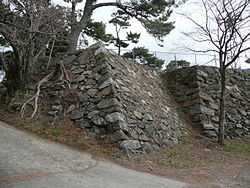Toba Domain (鳥羽藩, Toba-han) was a Japanese domain of the Edo period, located in Shima Province (part of modern-day Mie Prefecture), Japan. It was centered on Toba Castle in what is now the city of Toba.
History
During the Sengoku period, most of Shima Province came under the control of Kuki Yoshitaka, a retainer of Oda Nobunaga, who had a fleet of armored ships and controlled maritime traffic around Ise Bay. The Kuki clan fought on both sides during the Battle of Sekigahara, with Kuki Yoshitaka siding with the western forces loyal to Toyotomi Hideyori, and his son Kuki Moritaka, joining the eastern armies of Tokugawa Ieyasu.
With the establishment of the Tokugawa shogunate, Kuki Moritaka was confirmed as daimyō of Toba, initially with revenues of 35,000 koku, growing to 55,000 koku under his son Kuki Hisataka, who was transferred to Sanda Domain in Settsu Province.
The Kuki were replaced by the tozama Naito clan, which ruled Toba to 1680. The domain then reverted to tenryo status under the direct control of the shogunate for one year. It then came under the control of the Doi clan (1681-1691), Ogyu-Matsudaira clan (1691-1710), Itakura clan (1710-1717), and Toda-Matsudaira clan (1717-1725) before finally coming under the Inagaki clan (1725-1871), where it remained until the Meiji restoration.
As with all domains, Toba Domain was not a single contiguous holding, but was geographically scattered over a wide area. During the Bakumatsu era it ruled all of Shima Province (37 villages in Toshi District and 19 villages in Ago District) as well as 8 villages in Iino District, 4 villages in Taki District, and 5 villages in Watari District, all in Ise Province.
During the Boshin War, Inagaki Nagayuki remained loyal to the Shogunate, and as a result was fined heavily by the Meiji government and forced into retirement. His son, Inagaki Nagahiro became domain governor, and after the abolition of the han system in July 1871, Toba Domain became “Toba Prefecture”, which merged with the short lived “Watarai Prefecture” in November 1871, which later became part of Mie Prefecture.
List of daimyō
-
 Kuki clan (fudai) 1597-1632
Kuki clan (fudai) 1597-1632
| # | Name | Tenure | Courtesy title | Court Rank | revenues |
|---|
| 1 | Kuki Moritaka ( 九鬼守隆) | 1597–1632 | Nagato-no-kami | Lower 5th (従五位下) | 35,000 koku |
| 2 | Kuki Hisataka ( 九鬼久隆) | 1632–1632 | Yamato-no-kami | Lower 5th (従五位下) | 35,000 -–> 56,000 koku |
-
 Naito clan (fudai) 1633-1680
Naito clan (fudai) 1633-1680
| # | Name | Tenure | Courtesy title | Court Rank | revenues |
|---|
| 1 | Naito Tadashige ( 内藤忠重) | 1633–1653 | Shima-no-kami | Lower 5th (従五位下) | 35,000 koku |
| 2 | Naito Tadamasa ( 内藤忠政) | 1653–1673 | Hide-no-kami | Lower 5th (従五位下) | 35,000 koku |
| 3 | Naito Tadakatsu ( 内藤忠勝) | 1673–1680 | Izumi-no-kami | Lower 5th (従五位下) | 35,000 koku |
-
 Doi clan (fudai) 1681-1691
Doi clan (fudai) 1681-1691
| # | Name | Tenure | Courtesy title | Court Rank | revenues |
|---|
| 1 | Doi Toshimasa ( 土井利益) | 1691–1710 | Suwo-no-kami | Lower 5th (従五位下) | 70,000 koku |
| # | Name | Tenure | Courtesy title | Court Rank | revenues |
|---|
| 1 | Matsudaira Norisato (松平乗邑) | 1691–1710 | Izumi-no-kami | Lower 4th (従四位下) | 60,000 koku |
| # | Name | Tenure | Courtesy title | Court Rank | revenues |
|---|
| 1 | Itakura Shigeharu (板倉重治) | 1710–1717 | Tamba-no-kami | Lower 4th (従四位下) | 50,000 koku |
| # | Name | Tenure | Courtesy title | Court Rank | revenues |
|---|
| 1 | Matsudaira Mitsuchika (松平光慈) | 1590–1603 | Tamba-no-kami | Lower 5th (従五位下) | 70,000 koku |
-
 Inagaki clan (fudai) 1725-1871
Inagaki clan (fudai) 1725-1871
| # | Name | Tenure | Courtesy title | Court Rank | revenues |
|---|
| 1 | Inagaki Terukata ( 稲垣昭賢) | 1725–1752 | Shinano-no-kami | Lower 5th (従五位下) | 30,000 koku |
| 2 | Inagaki Terunaga ( 稲垣昭央) | 1752–1773 | Tsushima-no-kami | Lower 5th (従五位下) | 30,000 koku |
| 3 | Inagaki Nagamochi ( 稲垣長以) | 1773–1794 | Settsu-no-kami | Lower 5th (従五位下) | 30,000 koku |
| 4 | Inagaki Nagatsugu ( 稲垣長続) | 1794–1818 | Tsushima-no-kami | Lower 5th (従五位下) | 30,000 koku |
| 5 | Inagaki Nagakata ( 稲垣長剛) | 1818–1842 | Tsushima-no-kami | Lower 5th (従五位下) | 30,000 koku |
| 6 | Inagaki Nagaaki ( 稲垣長明) | 1842–1866 | Settsu-no-kami | Lower 5th (従五位下) | 10,000 koku |
| 7 | Inagaki Nagayuki ( 稲垣長行) | 1866–1868 | Settsu-no-kami | Lower 5th (従五位下) | 30,000 koku |
| 8 | Inagaki Nagahiro ( 稲垣長敬) | 1868–1871 | Tsushima-no-kami | Lower 5th (従五位下) | 10,000 koku |
|
References
- Papinot, E (1910). Historical and Geographic Dictionary of Japan. Tuttle (reprint) 1972.
- (Japanese) Toba on "Edo 300 HTML"

 Kuki clan (fudai) 1597-1632
Kuki clan (fudai) 1597-1632 Naito clan (fudai) 1633-1680
Naito clan (fudai) 1633-1680 Doi clan (fudai) 1681-1691
Doi clan (fudai) 1681-1691 Ogyū-Matsudaira clan (fudai) 1691-1710
Ogyū-Matsudaira clan (fudai) 1691-1710 Itakura clan (fudai) 1710-1717
Itakura clan (fudai) 1710-1717.svg.png) Toda-Matsudaira clan (fudai) 1717-1725
Toda-Matsudaira clan (fudai) 1717-1725 Inagaki clan (fudai) 1725-1871
Inagaki clan (fudai) 1725-1871